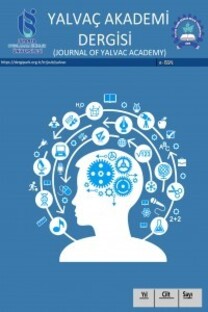ENNEAGRAM YOLUYLA ORGANİZASYONEL PERFORMANS: STRATEJİK PLANLAMA - YÖNETİM KARARI - OPERASYONEL KONTROL
Uzmanlık, kuruluşlar içinde ve arasında çeşitli istihbarat sistemlerinin tasarlanması ve oluşturulması için temel bir araçtır. Organizasyonlar, stratejik planlama ve operasyonel kontrollerine bağlı olarak farklı tasarım yönetimi stratejileri ve kararlarıyla yapılanmaktadır. Enneagram, eski geleneksel yöntemlerin küresel ölçekte günümüzün sorunlarını karşılayamadığı durumlarda açık bir vizyon oluşturmaya yönelik stratejik bir metodolojidir. Bu makale, organizasyonların operasyonel kontrolü, yönetimsel karar alma, stratejik planlama ve etkileşimli süreçlerinde bir çerçeve sunmayı amaçlamaktadır. Enneagram stratejileri, bilinçli yönetsel kararlar, operasyonel kontrol ve stratejik planlama arasındaki dinamiklere dayalı olarak organizasyonel performansı anlamaya ve artırmaya yönelik araçlardır. Çalışma ayrıca, birleştirici düşünmenin bilişsel stratejilerinin yenilikçi bir gelişim sürecine nasıl katkıda bulunabileceği de tartışılacaktır.
Anahtar Kelimeler:
Organizasyon yönetimi, Tasarım Yönetimi, Uzmanlık, Enneagram, Birleştirici düşünce, İnovasyon
ORGANIZATIONAL PERFORMANCE THROUGH THE ENNEAGRAM: STRATEGIC PLANNING - MANAGEMENT DECISION - OPERATIONAL CONTROL
Expertise is a primary tool for designing and building a variety of intelligence systems within and between organizations. Organizations are structured with different design management strategies and decisions depending on their strategic planning and operational control. Enneagram is the strategic methodology to create an open vision when old traditional methods do not meet today's problems on a global scale. This paper aims to present a framework for organizations in their operational control, managerial decision-making, strategic planning, and interactive processing. Enneagram strategies are tools to understand and increase organizational performance based on the dynamics between informed managerial decisions, operational control, and strategic planning. It will also discuss how cognitive strategies of associative thinking can contribute to an innovative development process.
Keywords:
Organization management business intelligence, design management, expertise, enneagram, associative thinking, innovation,
___
- 1. Koestler, Arthur. (1964) The act of creation. Picador, London.
- 2. Kagan, J. (1998). Three seductive ideas. Harvard University Press.
- 3. Kassing, J. W. (1997a). Articulating, antagonizing, and displacing: A model of employee dissent. Communication Studies, 48(4), 311-332.
- 4. Packer, D. J. (2010). The interactive influence of conscientiousness and openness to experience on dissent. Social Influence, 5(3), 202-219.
- 5. Palmer, H. (1995). The Enneagram in Love & Work: Understanding Your Intimate & Business Relationships. Harper, San Francisco.
- 6. Payne, H. J. (2007). The role of organization-based self-esteem in employee dissent expression. Communications Research Report, 24(3), 235-240.
- 7. Redding, C. W. (1985). Rocking Boats, Blowing Whistles, and Teaching Speech Communication. Communication Education, 34(3), 254-258.
- 8. Redmond, V., Jameson, J. K., & Binder, A. R. (2016). How superior–subordinate relationship quality and conflict management styles influence an employee’s use of upward dissent tactics. Negotiation and Conflict Management Research, 9(2), 158-176.
- 9. Riso, D. R., & Hudson, R. (2003). Discovering your personality type: The essential introduction to the enneagram, revised and expanded. Mariner Books.
- 10. Scott, S. A. (2011). An analysis of the validity of the Enneagram. Unpublished Doctoral Thesis. The College of William and Mary.
- Başlangıç: 2016
- Yayıncı: Isparta Uygulamalı Bilimler Üniversitesi
Sayıdaki Diğer Makaleler
ÖZÜR DİLEME MOTİVASYONLARI ÖLÇEĞİ: BİR ÖLÇEK UYARLAMA ÇALIŞMASI
Kutay ÖZDEMİR, Ahmet Sait ÖZKUL
ANADOLU KENTLERİNDE TARİHİ KİLİSELERİN YENİDEN İŞLEVLENDİRİLMESİ, ISPARTA AYA PAYANA ÖRNEĞİ
Hasan Şehmuz HAŞTEMOĞLU, Yasin TEKİN
JEOLOJİ MÜHENDİSLİĞİ EĞİTİMİNDE KADIN ÖĞRENCİLERİN YERİ
Akın AKBULUT, Behzat Gökçen DEMİR, Ali Koray ÖZDOĞAN
